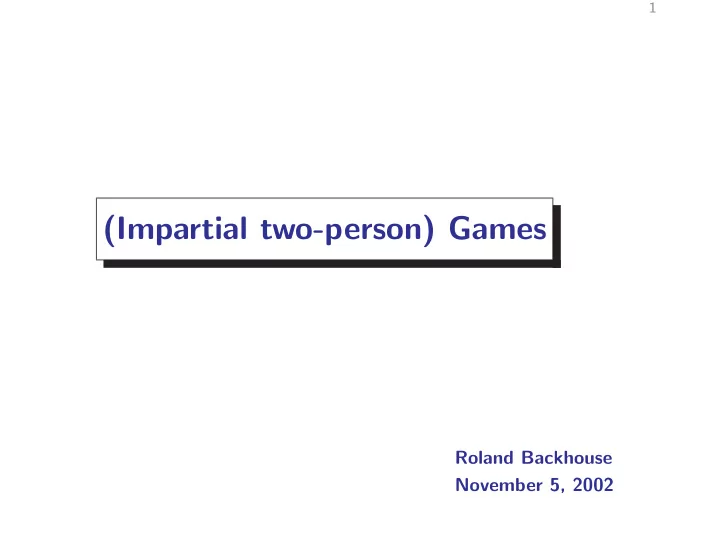

1 (Impartial two-person) Games Roland Backhouse November 5, 2002
2 Outline We use impartial, two-person games to illustrate the notions of least and greatest fixed points of a monotonic function. The winning and losing positions in a game satisfy fixed point equations. If the equations do not have unique solutions, stalemate is possible. The positions from which a win is guaranteed are characterised by the least fixed point of a certain equation. The positions from which losing is inevitable (against a perfect player) are also characterised by the least fixed point of a certain equation. The stalemate positions are characterised by greatest fixed points.
3 Two-person, Impartial Games A two-person, impartial game is given by a set of positions and a move relation on the positions. We use G , H , K , etc. to denote positions. The move relation is denoted by the symbol “ � → ”. So, G � → H means there is a move from position G to position H. The players take it in turns to move. The game is lost when no move can be made. Such games are called impartial because the same moves are available to both players. (Games like chess are partisan . Players can only move their own pieces.)
4 Winning and Losing Let W.G mean that G is a position from which a perfect player is guaranteed to win. Let L.G mean that G is a position from which losing is inevitable (against a perfect player). The predicates W and L satisfy the fixed point equations: W = � G :: �∃ H : G � → H : L.H �� = � G :: �∀ H : G � → H : W.H �� L In words, a winning position is one from which it is always possible to move to a losing position, and a losing position is one from which every move is to a winning position. These equations need not have unique solutions.
5 Examples Matchsticks. Lollipop.
6 Conjugate Predicate Transformers Consider the predicate transformers f and g given by f.X = � G :: �∃ H : G � → H : X.H �� g.X = � G :: �∀ H : G � → H : X.H �� Note that W = ( f ◦ g ) .W and L = ( g ◦ f ) .L Predicates are ordered by implication, and f and g are monotonic with respect to this ordering, as are ( f ◦ g ) and ( g ◦ f ). f and g are conjugates . That is, for all predicates X , ¬ ( f.X ) = g. ( ¬ X ) ¬ ( g.X ) = f. ( ¬ X ) ∧ As a consequence, so are ( f ◦ g ) and ( g ◦ f ): for all predicates X , ¬ (( f ◦ g ) .X ) = ( g ◦ f ) . ( ¬ X ) ∧ ¬ (( g ◦ f ) .X ) = ( f ◦ g ) . ( ¬ X )
7 Fixed Points of Conjugates Suppose f and g are monotonic, conjugate predicate transformers. Let µf denote the least fixed point of f . Let νf denote the greatest fixed point of f . Similarly, for g . Then, ¬ ( µf ) = νg This has corollary µf ∧ µg = false µf ∧ ( νf ∧ νg ) = false µg ∧ ( νf ∧ νg ) = false µf ∨ µg ∨ ( νf ∧ νg ) = true The set of states is thus divided into three disjoint sets, µf , µg and νf ∧ νg .
8 Winning, Losing and Stalemate We can apply the theory above to the predicate transformers f = � X :: � G :: �∃ H : G � → H : X.H ��� and g = � X :: � G :: �∀ H : G � → H : X.H ��� defined by an impartial game. The predicates µ ( f • g ) , µ ( g • f ) and ν ( f • g ) ∧ ν ( g • f ) are mutually distinct and together cover all positions. µ ( f • g ) characterises the positions from which a win is guaranteed. µ ( g • f ) characterises the positions from which losing is inevitable. ν ( f • g ) ∧ ν ( g • f ) characterises stalemate positions. (All these assume perfect players.)
Recommend
More recommend